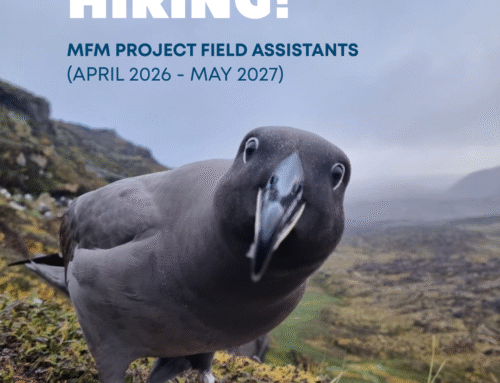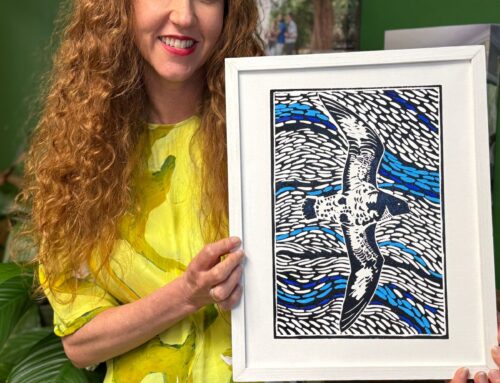Above picture: A Black-Faced Sheathbill tends its downy chick on Marion Island, photograph by Maëlle Connan
Ecosystem processes are changing worldwide, including from the impacts of invasive species being exacerbated by climate change. This is particularly obvious in the Southern Ocean where a warmer and drier environment is allowing the proliferation of species once limited by the cold climate. South Africa’s Special Nature Reserve, Marion Island, is no exception. The recent records of attacks by invasive House Mouse Mus musculus on the island’s threatened seabirds suggest a profound alteration of the natural ecosystem. This has led to the planned eradication of mice by the Mouse-Free Marion Project, currently intended for 2023.
For the next three years (2021-2023), a new South African National Antarctic Programme (SANAP) project entitled “Avian Scavengers as Indicators of Recovery of an Island Biota” co-led by Dr Maëlle Connan (Research Fellow in the Marine Apex Predator Research Unit, Nelson Mandela University) and Prof. Peter Ryan (Director of the FitzPatrick Institute of African Ornithology, University of Cape Town) will focus on three species of the island’s avian scavenger guild: Black-faced or Lesser Sheathbill Chionis minor, Kelp Gull Larus dominicanus and Brown or Subantarctic Skua Stercorarius antarcticus. By focusing on these three species and on some of their prey, the project intends first to fill identified scientific gaps that are crucial for the best planning of the mouse eradication. Second, these three scavengers will be used as indicators of recovery of the terrestrial ecosystem post-eradication by establishing baseline data for the scavenger guild and their prey against which the impact of a successful mouse eradication can be measured in years to come.

“AJ”, a colour-banded Brown Skua, eyes the photographer; by Maëlle Connan
Eleanor Weiderman, the field research assistant overwintering on the island for the project, has been conducting regular censuses to determine the seasonal presence and behaviours of these three scavenger species. The winter counts have now been completed by Eleanor, with the assistance of Isabel Micklem and Thando Cebekhulu, two ornithological research assistants who are also overwintering for Dr Azwianewi Makhado’s project under the South African Department of Forestry, Fisheries and the Environment (DFFE). These counts have been communicated to Dr Anton Wolfaardt, the Project Manager of the Mouse–Free Marion Project, to help with eradication planning.

Not that easy! Eleanor Weideman scans for scavengers among a large King Penguin Aptenodytes patagonicus colony, photograph by Yinhla Shihlomule
In addition, Eleanor, Isabel and Thando have been ensuring the continuation of the FitzPatrick Institute’s long-term monitoring of Northern Giant Petrels Macronectes halli and Wandering Diomedea exulans and Grey-headed Thalassarche chrysostoma Albatrosses – all species whose chicks are being attacked and killed by mice. Wandering Albatross chicks in the three study colonies on the island’s east coast were banded in July, and with the Northern Giant Petrels having started laying in August, this marks the start of a busy breeding season ahead!
Dr Maëlle Connan, Research Fellow, Marine Apex Predator Research Unit, Nelson Mandela University, Gqeberha, South Africa, 31 August 2021











